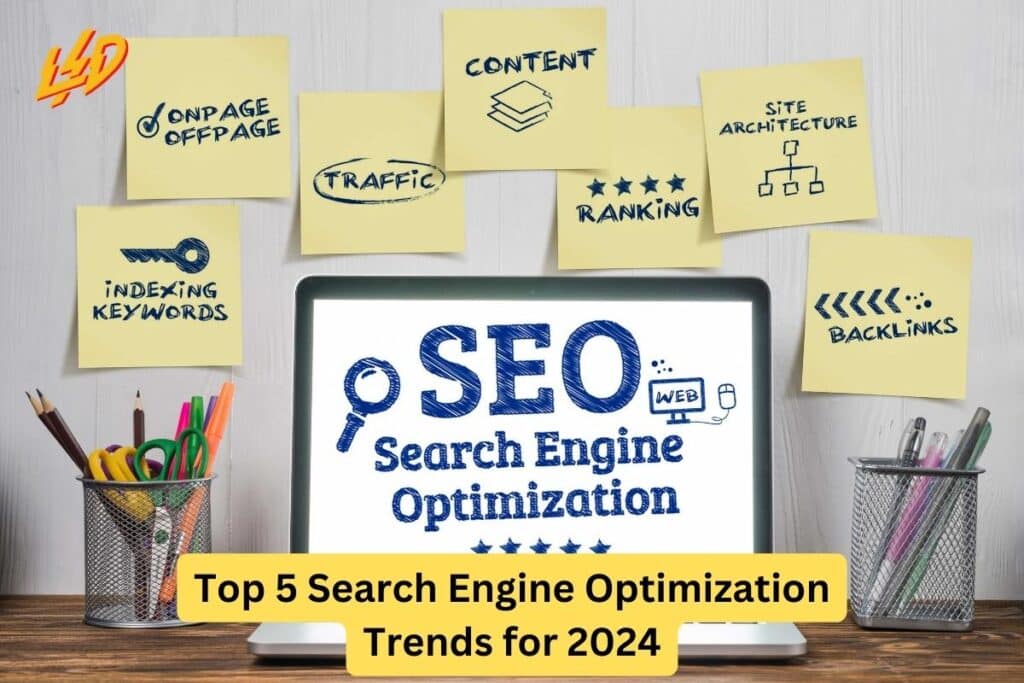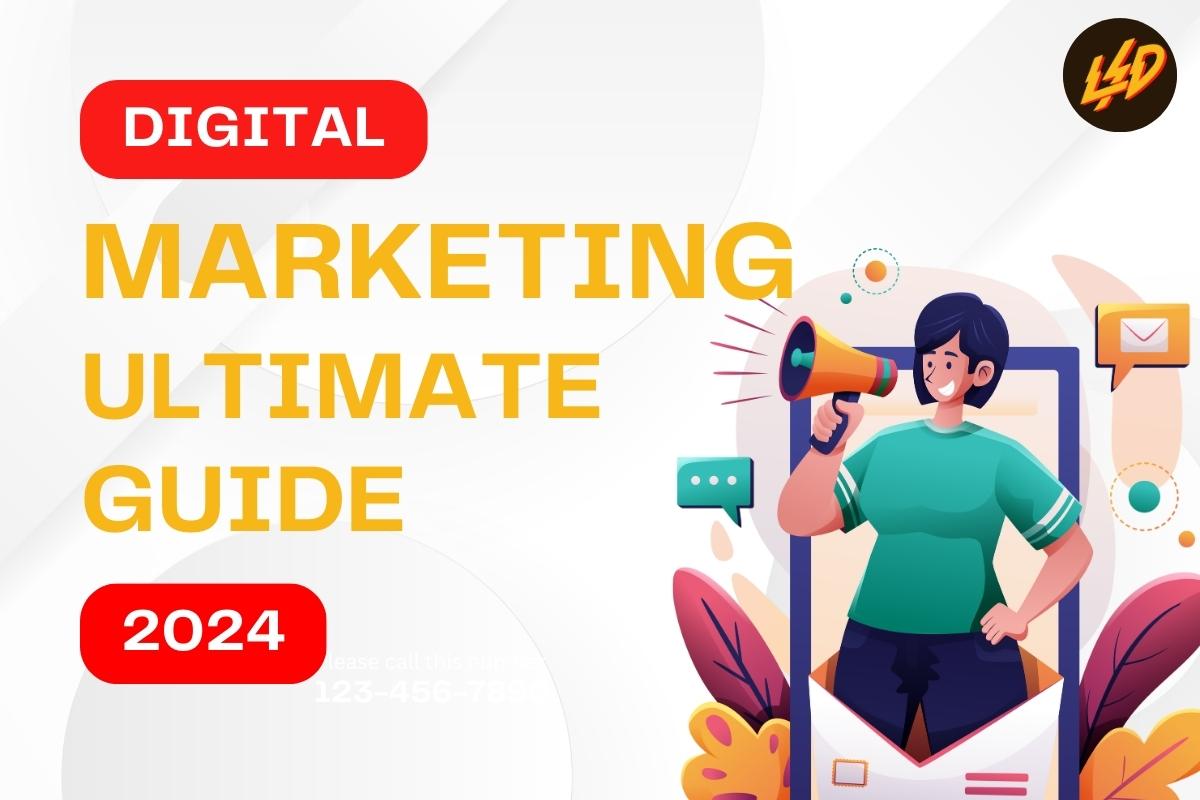As we step into the future of digital marketing, adapting to the ever-evolving landscape of search engine optimization (SEO) is pivotal for success. In 2024, the competition to rank high on search engine result pages (SERPs) is fiercer than ever. This means digital marketers, SEO professionals, content creators, and online businesses need to be well-versed in the latest trends to maintain visibility and drive organic traffic.
Let’s explore the Top 5 SEO Trends that are about to redefine the digital marketplace in 2024, ensuring your strategy is not just up-to-date but future-proof.
1. AI-Driven SEO
Artificial intelligence (AI) is transforming SEO strategies by providing insights that are faster and more accurate than human analysis. AI algorithms can now predict SERP rankings, analyze user behavior patterns, and personalize content in real-time. In 2024, AI-driven tools like chat GPT-3 are indispensable for:
- Understanding searcher intent
- Optimizing for long-tail keywords
- Creating highly relevant and user-focused content
Detailed Guide:
- Leverage Predictive Analytics: Utilize AI tools that can predict trends and consumer behavior. By analyzing past search data, these tools can forecast upcoming opportunities for your content to capture audience interest before it peaks.
- Semantic Keyword Optimization: Move beyond traditional keyword stuffing. Use AI software to understand the context and variations of long-tail keywords, allowing you to create content that answers the questions your audience is actually asking.
- Automated Content Creation: Some AI programs can help you craft initial drafts of content. They analyze high-ranking pieces and incorporate SEO best practices, which you can then refine to add a personal touch.
Tips and Tricks:
- Embrace Machine Learning: Regularly feed your AI tools data from your website analytics. Machine learning algorithms will get better at predicting patterns and suggesting optimizations over time.
- A/B Testing: Use AI to run A/B tests on your content. This will identify which versions work best with your audience, providing empirical data to back up your SEO strategy.
Example of AI in Action:
Imagine you run a travel blog. An AI-driven SEO tool could help you discern that users searching for “best European vacations” also often look for “affordable European cities” and “Europe travel itineraries”. By generating content that covers these related topics, you can potentially rank for a broader set of terms.
Personal Tips:
- Stay Updated: AI in SEO is a rapidly evolving field. Regularly update your knowledge and your tools to stay competitive.
- Quality Over Quantity: While AI can generate content quickly, it’s vital to maintain high standards. Ensure that every piece of content is informative, valuable, and engaging to foster trust and authority.
By integrating these advanced strategies into your SEO efforts, you can tap into the full potential of AI-driven search engine optimization, making your website more visible and user-friendly than ever before.
2. Voice Search Optimization
With smartphones and smart home devices gaining omnipresence, voice search is becoming the norm. As SEO professionals, optimizing for voice search is non-negotiable. This involves focusing on:
- Natural language processing (NLP)
- Long-tail keyword phrasing that matches how real people talk
- Conversational content that answers direct questions
Detailed Guide:
- Understand Natural Language: Embrace NLP technology to help your content resonate with the conversational tone of voice queries. Tools that analyze voice search patterns can assist in understanding the nuances of speech.
- Long-Tail Keyword Research: Invest time in researching long-tail phrases that are commonly spoken, not just typed. People tend to use full sentences or questions when speaking, so include these in your content strategy.
- Create FAQ Pages: Compile frequently asked questions related to your business or content, and provide clear, conversational answers. Voice search queries often come in the form of questions, and FAQ pages can directly cater to this.
Tips and Tricks:
- Imitate Spoken Queries: Speak out loud the types of questions potential visitors might ask and record these. Use this as a base for your content.
- Localize Your SEO: Local search queries are prevalent in voice searches. Ensure that your business is listed accurately on maps and local directories with updated contact information.
- Use Structured Data: Implement schema markup so search engines can easily understand the context of your content, helping it rank higher in voice search results.
Example of Voice Search in Action:
Consider a local bakery: if a potential customer uses voice search to find “birthday cakes near me,” having your business appear in these results is crucial. Ensure you’ve optimized for local SEO, have relevant content (like a blog post titled “How to Choose the Perfect Birthday Cake”), and your site’s structured data indicates your location and offerings.
Personal Tips:
- Conversational Tone Matters: Write your content as if you’re speaking to someone directly. Be engaging and natural. Remember, people will often hear the content read out loud by their devices.
- Regularly Test Voice Search Performance: Occasionally do voice searches yourself to see where your site ranks and how voice assistants are interpreting your content. This hands-on approach can yield insights for further optimization.
By adopting these detailed strategies and personal tips for voice search optimization, you’ll be better positioned to meet the demands of increasingly savvy users who utilize voice search as their go-to method for finding information online.
3. Video SEO
Video content is not just engaging; it is also a powerful tool for improving search rankings. Platforms like YouTube are search engines themselves, and videos often appear in SERPs. Thus, in 2024, optimizing video content entails:
- Using precise, keyword-rich video titles and descriptions
- Leveraging closed captions for indexable text
- Creating video sitemaps for increased discoverability
Detailed Guide:
- Keyword-Rich Titles and Descriptions: Research and use relevant keywords that your target audience is searching for. The title should be concise yet descriptive and the description should expand on the title, providing additional context and including targeted keywords without overstuffing.
- Leverage Closed Captions: Closed captions not only make your video accessible to a wider audience, including those with hearing impairments, but also provide indexable content for search engines. Use accurate transcripts and include keywords naturally within the spoken content.
- Video Sitemaps: To ensure search engines index your videos properly, create and submit a video sitemap. Include video title, description, play page URL, thumbnail, and raw video file location, which aids search engines in understanding and ranking your video content efficiently.
Tips and Tricks:
- Thumbnail Selection: Choose a captivating thumbnail that accurately represents the content of your video. This can significantly impact your click-through rate.
- Engage with Viewers: Encourage viewers to like, comment, and share your videos. Engagement metrics play a role in how algorithms prioritize content.
- Monitor Analytics: Use analytics tools to understand your video’s performance. Focus on watch time, view count, and engagement rates to gain insights and optimize future content.
Example of Video SEO in Action:
A local fitness trainer creates a series of workout videos. To optimize for search engines, they conduct keyword research and find that “15-minute home workouts” is a highly searched term. They title their video “15-Minute Home Workout for Beginners” and include a detailed description with related keywords. They upload closed captions and a sitemap with all the required details. The video uses an attractive thumbnail of the trainer in action, and through the video, they actively encourage viewers to engage by asking them to leave comments about their experience.
Personal Tips:
- Consistency is Key: Post videos on a regular schedule to keep your audience engaged and the algorithms favoring your content.
- Optimize Video Length: Keep your videos long enough to cover the subject in-depth but short enough to maintain viewer engagement throughout.
- Master the Hook: Start your video with a compelling hook within the first few seconds to grab attention and reduce bounce rates.
- Collaborate with Others: Partner with influencers or brands related to your niche to boost visibility and extend your reach.
By following these detailed guides, tips, and examples, you can craft a Video SEO strategy that potentially increases your visibility and authority on video platforms and in search engine results, while simultaneously providing value to your audience.
4. Local SEO
Local SEO remains crucial for businesses aiming to capture local markets. With Google My Business and other local listings playing a vital role in online presence, companies in 2024 should:
- Keep local listings and information up-to-date
- Gather and manage local reviews
- Optimize for “near me” searches with localized content and backlinks
Detailed Guide for Local SEO:
- Accurate Local Listings: Ensure your business’s name, address, and phone number (NAP) are consistently listed across all online directories. This includes not just Google My Business but also places like Yelp, Yellow Pages, and industry-specific directories.
- Local Reviews: Solicit reviews from your customers by reminding them after a purchase or service. Positive local reviews can improve your search rankings and can also provide valuable feedback for your business. Respond to all reviews, both positive and negative, in a professional manner.
- Localized Content: Craft content that resonates with your local audience. Your website should highlight local relevance through community events, local news, or features of your area.
Tips and Tricks for Effective Local SEO:
- Utilize Google My Business Features: Regularly update your GMB profile with posts, offers, and events, and make use of all available features, such as messaging and Q&A, to engage directly with your audience.
- Local Keyword Optimization: Conduct keyword research to identify terms that potential customers use when searching for local services, and incorporate them into your website’s meta tags, content, and URLs.
- Mobile Optimization: Ensure your website is mobile-friendly, as local searches often occur on mobile devices. A responsive design and fast loading times are critical.
Example of Local SEO in Action:
A restaurant in downtown Chicago might optimize its website to appear when users search for “best Italian restaurant in downtown Chicago.” They keep an updated profile on local directories, and their website features reviews and testimonials from local customers. They create blog posts about local events they cater to and update their Google My Business profile with weekly specials and events, which appear directly in search results.
Personal Tips:
- Engage Locally on Social Media: Utilize social media platforms to engage with the local community. Share local news, participate in local events, and use local hashtags to increase visibility.
- Monitor Local Competitors: Keep an eye on your competitors’ local SEO strategies. Learn from their successes and improve on their weaknesses to differentiate your business.
- Local Backlinks: Build relationships with other local businesses and websites to create backlinks to your site. This can improve your domain authority and help with local search rankings.
By implementing these detailed guidelines, embracing the tips and tricks, and studying the example provided, businesses can elevate their local SEO efforts and improve their visibility to consumers in their immediate area. These efforts ultimately contribute to stronger online presence, increased foot traffic, and better search engine rankings.
5. AI Content & SEO Integration
Combining AI content generation with SEO optimization is emerging as a force multiplier for content creators. While AI assists in creating diverse content that can scale, integrating SEO best practices ensures that content remains useful and ranks well. This synergy is essential for:
- Generating large volumes of targeted content swiftly
- Ensuring consistency in SEO practices across all content formats
- Adapting to user feedback for continuous improvement in content relevance
Detailed Guide for AI Content & SEO Integration:
- Content Planning with AI: Use AI to analyze search trends and patterns, gather insights on what your audience is seeking, and plan your content accordingly. This data-driven approach helps target specific keywords and topics.
- Consistent Brand Voice: Employ AI tools to maintain a consistent brand voice across all your content, but ensure human oversight to retain the authenticity and nuance that AI may not fully capture.
- SEO-Optimized AI Content: Use AI to generate content but always apply SEO principles by integrating keywords thoughtfully, ensuring meta descriptions are optimized, and the content structure is search engine friendly.
Tips and Tricks for Effective AI Content & SEO Integration:
- Quality Over Quantity: While AI can produce a high volume of content, prioritize quality to ensure that each piece is valuable, informative, and engaging.
- Human-AI Collaboration: Let AI handle the first draft of content, then refine and personalize it with a human touch to ensure it aligns with your brand’s messaging and audience’s expectations.
- Analytics & Feedback: Integrate tools that allow you to measure the performance of your AI-generated content, and use this feedback to improve future content and SEO strategies.
Example of AI Content & SEO Integration in Action:
A tech company uses AI to generate informative blog posts about their latest product features. The AI tool drafts content that aligns with the suggested outline and SEO guidelines. The marketing team edits the draft to inject brand personality and ensures that keywords are used appropriately. They monitor user engagement with the content through analytics and tweak their strategy based on user behavior and feedback.
Personal Tips:
- Always Review AI-Generated Content: No matter how advanced AI gets, it’s crucial to review and edit the content. This ensures it meets quality standards and resonates with readers.
- Keep Updated on SEO Trends: Search rankings algorithms evolve, so stay updated on latest SEO trends and adjust your content accordingly to maintain its effectiveness.
- Adapt and Evolve: Use AI-generated content as a learning tool. Analyze its performance and continuously adapt your content and integration strategies based on data-driven insights.
By utilizing these detailed guides, embracing practical tips, examining the example provided, and employing personalized strategies, businesses and content creators can harness the power of AI Content and SEO Integration to elevate their online presence and meet their audience’s needs effectively.
Get More Guide: How to Improve Your Website’s Ranking with Effective On-Page SEO?
Conclusion
The SEO landscape in 2024 revolves around embracing technology developments and reaffirming the importance of user experience. As search engines become smarter, SEO strategies must also evolve. By keeping pace with these trends—AI-driven SEO, voice search optimization, video SEO, local SEO, the E-A-T principle, and AI content integration—businesses can secure their place at the vanguard of digital visibility and engagement.
Remember that SEO is not a one-off effort but a continuous process. The digital marketers and SEO professionals who will thrive in 2024 are those who persistently learn, adapt, and develop innovative techniques to stay ahead of search algorithms and market trends.
Optimize today for a brighter digital tomorrow!
View More: 10 AI Tools to Boost Your LinkedIn Content Strategy
















